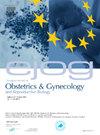Retracted vs non-retracted obstetrical randomized trials: Which quality criteria are most associated with retraction for untrustworthiness?
IF 2.1
4区 医学
Q2 OBSTETRICS & GYNECOLOGY
European journal of obstetrics, gynecology, and reproductive biology
Pub Date : 2025-03-23
DOI:10.1016/j.ejogrb.2025.03.047
引用次数: 0
Abstract
Background
Randomized control trials (RCTs) are an essential pillar of scientific knowledge and medical practice, and their integrity has important implications for reliable systemic reviews and meta-analyses. However, the number of article retractions due to falsified data and scientific misconduct has increased in recent years. In response, the scientific community has pursued the creation of quality criteria that can be utilized to promote trustworthiness.
Methods
After a quality criteria checklist was created by a team of experts, retracted and nonretracted studies were evaluated for adherence to assess the checklist’s usefulness and identify potential pitfalls. Retracted studies published in obstetric literature and retracted between 1994–2024 were identified using the online Retraction Watch Database. A previously created database of non-retracted obstetric RCTs published between 2018–2020 was used for the control group.
Results
A total of 173 studies were identified, 136 non-retracted and 37 retracted. Overall, 13 of 17 (76.5 %) criteria were statistically different between retracted and non-retracted articles. A cutoff of ≤ 11 total quality criteria granted 94.9 % (95 % CI, 89.7 − 97.9) sensitivity and 78.4 % (95 % CI, 61.8 − 90.2) specificity in distinguishing non-retracted from retracted studies.
Conclusions
Retracted studies were significantly less likely to adhere to the 17-quality criteria checklist compared to non-retracted studies, providing useful insight to peer-reviewed scientific journals about what to evaluate for in an RCT manuscript prior to publication. The authors recommend that journal editors play close attention to criteria related to research ethics, data falsification, and risk of bias.
求助全文
约1分钟内获得全文
求助全文
来源期刊
CiteScore
4.60
自引率
3.80%
发文量
898
审稿时长
8.3 weeks
期刊介绍:
The European Journal of Obstetrics & Gynecology and Reproductive Biology is the leading general clinical journal covering the continent. It publishes peer reviewed original research articles, as well as a wide range of news, book reviews, biographical, historical and educational articles and a lively correspondence section. Fields covered include obstetrics, prenatal diagnosis, maternal-fetal medicine, perinatology, general gynecology, gynecologic oncology, uro-gynecology, reproductive medicine, infertility, reproductive endocrinology, sexual medicine and reproductive ethics. The European Journal of Obstetrics & Gynecology and Reproductive Biology provides a forum for scientific and clinical professional communication in obstetrics and gynecology throughout Europe and the world.

 求助内容:
求助内容: 应助结果提醒方式:
应助结果提醒方式:


